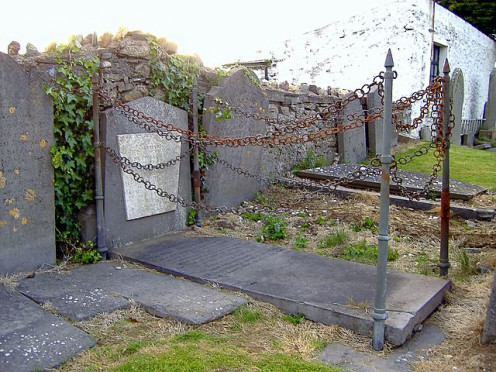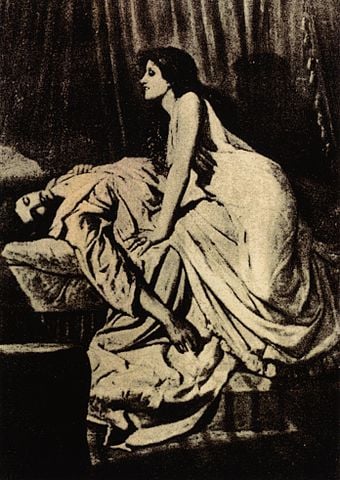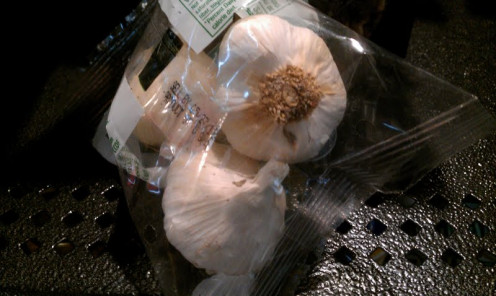Vampire Myths and Legends

Vampires have never been one hundred percent consistent in their numerous appearance in fiction, yet the vampires that appear in “Carmilla,” Dracula, and Salem’s Lot do have numerous similarities. “Carmilla” is the earliest of the three, and as such can be viewed as the basis for both other works, as Stoker obviously uses some of Le Fanu’s concepts, and King obviously and admittedly borrows from Stoker, even citing Dracula within the text as one of the books the vampire fighters refer to.
These three stories present a good cross-section of vampires. While some beliefs stay the same, others change slightly, or are not even an issue. The basic tenets of vampirism -- blood sucking and sleeping during daylight -- stay fairly consistent, but other less important details blur between stories.
Similarities
The vampire Carmilla has human helpers to get her moved during daylight hours and times when she is weak. This is a direct parallel between Dracula and Barlow. Dracula uses several go-between, including a band of gypsies, and Barlow has Straker for his human companion, used to protect him from intruders and prepare his way.
Carmilla stages elaborate scenes in order to be invited to stay in a house. She enters the homes after being asked to come live there, normally for months, during which time she sucks the blood from her host, and normally kills a few peasants (or so it seems). Dracula has the same problem, using Renfield to be invited into the asylum to drink from Mina, and needing to enslave Lucy outside of her home in order to secure the invitation to enter. King plays heavily on the need for an invitation, even having Matt revoke a previously given invitation to enter, forcing the vampire (Mike) back out into the night.

Victims
Carmilla is drawn to young women, with an attraction that is both sexual and hunger-based. Her victims, that we learn of, are always women. Dracula also seems to take only female victims, his only male “victim” being left to the women to finish off. He speaks of his intent to take Harker, but never fulfills this promise. King does not follow this trend, and instead seems to have more male than female victims. The few female victims come later, and one of them, Susan, is the first to be destroyed.
Egomania
A common threat is the egomania of the vampires. Each is secure in their knowledge that they are more intelligent and powerful than their human enemies and that they will prevail against them. Carmilla does not fear detection from the humans she stays with, Dracula believes he will triumph even as he returns home to regroup and start the fight anew, and Barlow believes he is secure in his hiding place, leaving Susan behind to taunt his tormentors.
Sparkly or Deadly?
What kind of vampire do you prefer?
Repulsion and Attraction
In all three stories, people who meet vampires feel a repulsion when they see them, but are entranced and attracted to them as well. Laura, Carmilla’s victim, wants to shy away from her, but she finds herself unable. Looking into Dracula’s eyes is the ruin of many characters within Dracula. Regardless of knowing how evil he, and his minions, truly are, it is nearly impossible to fight him. The same is true of Barlow in Salem’s Lot. Mark almost loses the fight in its final stages, and only through his will and determination does Ben prevail, refusing to look into Barlow’s eyes, fighting the attraction he feels.
Religious items are anathema for vampires. Carmilla is greatly distressed by hearing a funeral (religious) hymn being sung by the peasants as they walk by, claiming it is discordant and hurts her ears. Similarly, Dracula is repulsed by a cross, or indeed anything else holy, and Barlow and his fellow vampire minions, are held back by anything with religious belief behind it, including a cross made by tongue depressors. A further show of how religious icons impact vampires is seen in Dracula and Salem’s Lot in that Father Callahan and Mina are both unable to touch anything holy. Neither of them are full-fledged vampires, but both have drunk vampire blood (albeit unwillingly) and are cursed.
Salem's Lot Trailer
Killing or Turning Their Victims
Vampires seem to be able to kill quickly or slowly in all three stories. Dracula takes some victims quickly, draining them and restoring his health and vitality almost overnight, while other times he seems to carry on for weeks, such as his relationship with Lucy. Carmilla take both peasant women, some lingering for up to two weeks, but also stays with Laura for much longer than this, slowly draining her. Finally, Salem’s Lot is made up of vampires that both return to do the job over time, such as Danny Glick taking his mother, but also quickly, such as Barlow taking Susan.
Becoming a vampire is something that the three authors don’t seem to fully agree on. King never fully explains what it takes to become a vampire, other than a simple bite. Suicides are never mentioned, yet they feature prominently as a method to becoming a vampire in both Carmilla and Dracula. According to King, merely being bit changes you, and Dr. Cody is even able to “cure” himself by cleaning and sterilizing a bite, seeming to imply that it is a disease or something else carried within the saliva or blood of the vampires. However, both Carmilla and Dracula don’t seem to turn everyone they touch into vampires. It is implied in Carmilla that some of her peasant victims may turn into vampires, or may have at some point in the past, but there are no vampires made during Laura’s story. Dracula, however, seems to make vampires in two distinct ways -- either by sharing blood back and forth, or by letting someone who has been bitten die while under the vampire’s spell.
Shape-Shifting
The ability to change shape is another point on which the authors vary. Carmilla changes shape sometimes, into something large (about five feet, according to Laura) and ill-defined, but which seems able to resolve itself into the shape of a black cat. She also has the ability to slip through locked doors and windows, which makes it easy to assume that she has some ability to turn into mist or some other substance that can pass through walls. Dracula has the ability to change into mist, bats, and dogs, and possibly other creatures as well. Stoker doesn’t put many limits on this ability. King doesn’t address it at all. There is no mention of strange animals that change, and while his vampires seem to have the ability to levitate (similar to Dracula’s ability to climb vertical walls), there is no other mention of true supernatural powers that others have associated with them.
Eating
Carmilla seems to have one skill that the other vampires lack -- she consumes human food. While it is only mentioned once, it is mentioned that Carmilla drinks a cup of chocolate when she awakens. Dracula and his minions never seem to take food, and Mina’s sudden appetite lose is one sign that she is changing. King’s vampires no longer eat, or drink, and any attempts to do so, like Mike’s drinking of beer, end with the vampire vomiting the food back up.

Vampire Weaknesses
King and Stoker agree that vampires are helpless during the day, trapped in their coffins or hiding places, unable to stand the sun. Those who are in the process of changing, including Mina, Susan’s boyfriend, and even the Glick mother, can tolerate some sunlight, but feel weak and don’t enjoy the light at all. They generally start sleeping all day not too long into their change. Carmilla, however, seems to wake every day at 1 P.M. This may be because of the area where Carmilla takes place, especially if it is winter. But even then, when she awakens, she is able to move about, although weakened by the sunlight. This is in contrast to King’s and Stoker’s vampires, who are trapped by light.
Vampire Strengthes
One thing that all the stories agree on is the strength of their vampires. All the vampires encountered in “Carmilla,” Dracula, and Salem’s Lot are strong and fast, able to fight and escape. They are quicker than their human counterparts, and can win any fight that requires strength.
While coffins seem to be the resting place of choice, the issue of native soil never comes up in Carmilla as she is in her homeland. Dracula brings his soil with him, but Barlow just seems to bring a coffin. Whether or not any native soil is transported does not appear within the story.
Wounds from being bitten (and indeed, even other physical marks) disappear from the victims in two of the three stories. It is never addressed in Carmilla, but happens multiple times in Dracula and Salem’s Lot.

Killing Vampires
The method for killing the vampires does not vary greatly. A stake through the heart is the first step in all three cases. In both Dracula and Carmilla, the second step is beheading. Once the head is severed from the body, there are two choices. In Dracula, garlic is placed in the mouth. (Garlic is not mentioned in Salem’s Lot or Carmilla as a way to dissuade vampires.) In Carmilla, the final step is burning.








